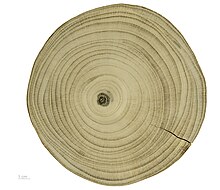Ginkgo (
Ginkgo biloba)
DBH: 73.31 cm measured on 2/18/2022
From Wikipedia the free encyclopedia,
Ginkgo biloba, commonly known asginkgoorgingko(/ˈɡɪŋkoʊ,ˈɡɪŋkɡoʊ/GINK-oh, -goh)[5][6]also known as themaidenhair tree,[7]is a species of tree native to China. It is the last living species in the orderGinkgoales, which first appeared over 290 million years ago. Fossils very similar to the living species, belonging to the genusGinkgo, extend back to theMiddle Jurassicapproximately 170 million years ago.[2]The tree was cultivated early inhuman historyand remains commonly planted.
Ginkgo leafextractis commonly used as adietary supplement, but there is noscientific evidencethat it supports human health or is effective against any disease.[8][9]
The genus name is regarded as a misspelling of theJapanese pronunciationgin kyofor thekanji銀杏 meaning "silver apricot",[10]which is found inChinese herbologyliterature such as日用本草(Daily UseMateria Medica) (1329) andCompendium of Materia Medica本草綱目published in 1578.[11]
Despite its spelling, which is due to a complicated etymology including a transcription error, "ginkgo" is usually pronounced/ˈɡɪŋkoʊ/, which has given rise to the common alternative spelling "gingko". Thespelling pronunciation/ˈɡɪŋkɡoʊ/is also documented in some dictionaries.[12][13]
Engelbert Kaempferfirst introduced the spellingginkgoin his bookAmoenitatum Exoticarum. It is considered that he may have misspelled "Ginkyo" as "Ginkgo". This misspelling was included byCarl Linnaeusin his bookMantissa plantarum IIand has become the name of the tree's genus.[14][12]
Ginkgos are large trees, normally reaching a height of 20–35m (66–115ft),[15]with some specimens in China being over 50m (165ft). The tree has an angularcrownand long, somewhat erratic branches, and is usually deep rooted and resistant to wind and snow damage. Young trees are often tall and slender, and sparsely branched; the crown becomes broader as the tree ages. A combination of resistance to disease, insect-resistant wood, and the ability to formaerial rootsand sprouts makes ginkgos durable, with some specimens claimed to be more than 2,500years old.[16]
Leaves[
edit]
 Ginkgo
Ginkgoleaves in summer
 Ginkgo
Ginkgoleaves in
autumnTheleavesare unique among seed plants, being fan-shaped with veins radiating out into the leaf blade, sometimes bifurcating (splitting), but neveranastomosingto form a network.[17]Two veins enter the leaf blade at the base and fork repeatedly in two; this is known asdichotomous venation. The leaves are usually 5–10cm (2–4in), but sometimes up to 15cm (6in) long. The old common name,maidenhair tree, derives from the leaves resemblingpinnaeof the maidenhair fern,Adiantum capillus-veneris.[citation needed]Ginkgos are prized for their autumn foliage, which is a deepsaffron yellow.
Leaves of long shoots are usually notched or lobed, but only from the outer surface, between the veins. They are borne both on the more rapidly growing branch tips, where they are alternate and spaced out, and also on the short, stubby spur shoots, where they are clustered at the tips. Leaves are green both on the top and bottom[18]and have stomata on both sides.[19]During autumn, the leaves turn a bright yellow, then fall, sometimes within a short space of time (one to 15days).[citation needed]
Branches[
edit]
Ginkgo branches grow in length by growth of shoots with regularly spaced leaves, as seen on most trees. From theaxilsof these leaves, "spur shoots" (also known as short shoots) develop on second-year growth. Short shoots have very shortinternodes(so they may grow only one or two centimeters in several years) and their leaves are usually unlobed. They are short and knobby, and are arranged regularly on the branches except on first-year growth. Because of the short internodes, leaves appear to be clustered at the tips of short shoots, and reproductive structures are formed only on them (see pictures below – seeds and leaves are visible on short shoots). In ginkgos, as in other plants that possess them, short shoots allow the formation of new leaves in the older parts of the crown. After a number of years, a short shoot may change into a long (ordinary) shoot, or vice versa.[citation needed]
 Ginkgo biloba
Ginkgo bilobacross section of tree trunk (source:
Muséum de Toulouse)Ginkgo prefers full sun and grows best in environments that are well-watered and well-drained. The species shows a preference for disturbed sites; in the "semiwild" stands at
Tianmu Mountains, many specimens are found along stream banks, rocky slopes, and cliff edges. Accordingly, ginkgo retains a prodigious capacity for vegetative growth. It is capable of sprouting from embedded buds near the base of the trunk (
lignotubers, or basal chichi) in response to disturbances, such as soil erosion. Old individuals are also capable of producing aerial roots on the undersides of large branches in response to disturbances such as crown damage; these roots can lead to successful clonal reproduction upon contacting the soil. These strategies are evidently important in the persistence of ginkgo; in a survey of the "semiwild" stands remaining in
Tianmushan, 40% of the specimens surveyed were multistemmed, and few saplings were present.
[20]: 86–87 Reproduction[
edit]
Ginkgo bilobaisdioecious, with separatesexes, some trees beingfemaleand others beingmale.[21]Male plants produce smallpollen coneswithsporophylls, each bearing twomicrosporangiaspirally arranged around a central axis.
Female plants do not produce cones. Twoovulesare formed at the end of a stalk, and afterwind pollination,[22]one or both develop into seeds. The seed is 1.5–2cm long. Its fleshy outer layer (thesarcotesta) is light yellow-brown, soft, andfruit-like. It is attractive in appearance, but containsbutyric acid[23](also known as butanoic acid) and smells like rancidbutteror vomit[24]when fallen. Beneath the sarcotesta is the hardsclerotesta(the "shell" of the seed) and a paperyendotesta, with thenucellussurrounding the femalegametophyteat the center.[25]